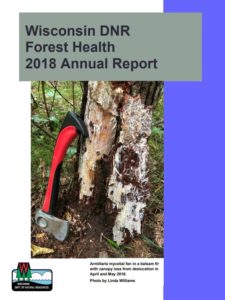
2018 Forest Health Annual Report now available.
The Forest Health Annual Report summarizes notable impacts pests, diseases and weather on the health of Wisconsin’s forests. The report is a collaborative product written by DNR forest health specialists from around the state. It outlines the damage and spread of both native and invasive pests and diseases during that year and puts these into context of observations from previous years. Management programs and their results are also described. Highlights from the 2018 annual report include:
- American beech with resistance to disease-causing scale insect entered into a breeding program for species conservation and reintroduction
- Confirmation of jumping worms in northern counties
- Biological control of emerald ash borer
- Closure of the state gypsy moth suppression program
- Innovation in survey of the invasive plant lesser celandine
- Dieback and mortality in balsam fir caused by freezing weather in April followed by unseasonably hot temperatures in early May
The 2018 report and others dating back to 2003 are available on the forest health publications page. Historical reports dating back to 1951 are archived and available upon request. Contact Marguerite Rapp at marguerite.rapp@wisconsin.gov for more information on the archived reports.
